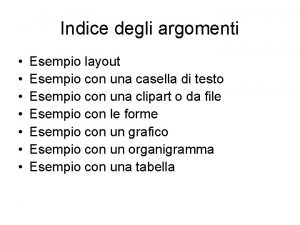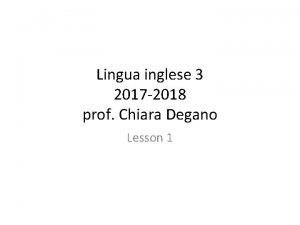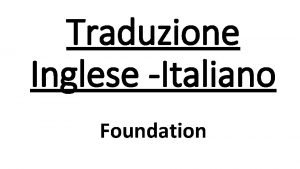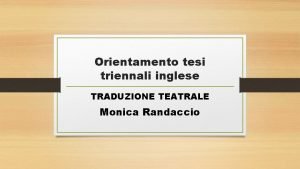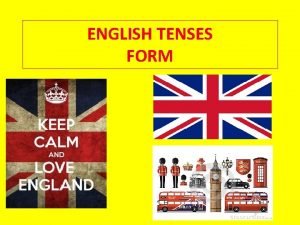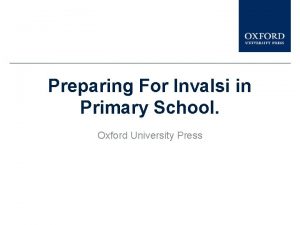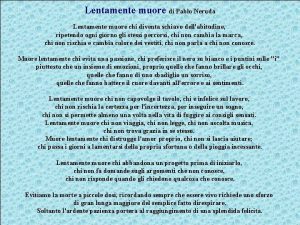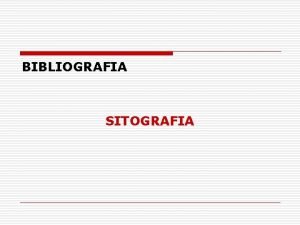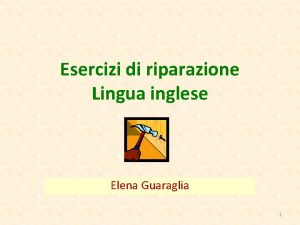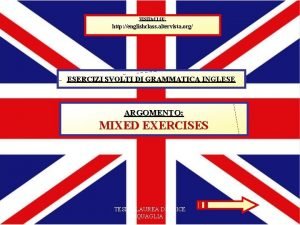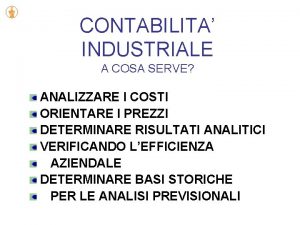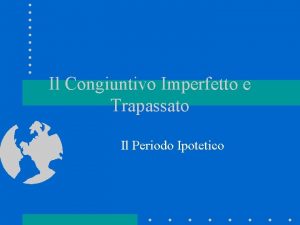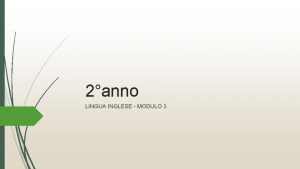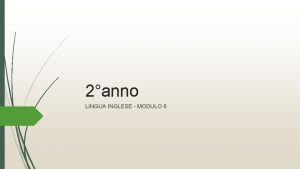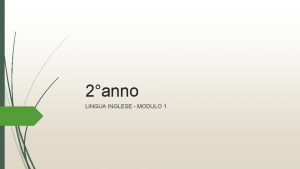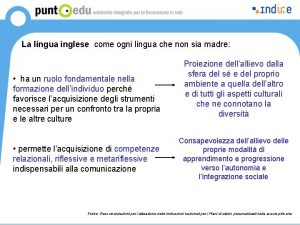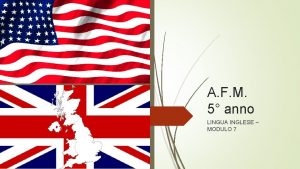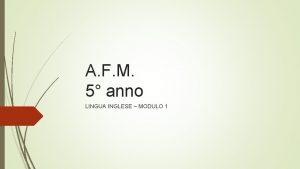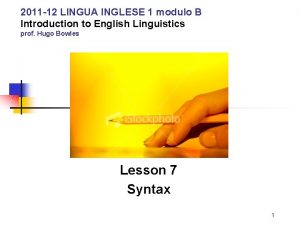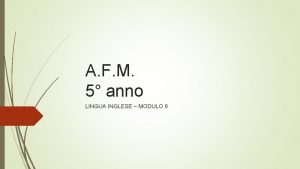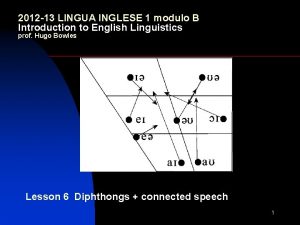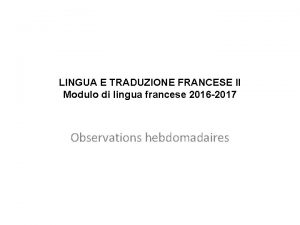2anno LINGUA INGLESE MODULO 2 MODULO 2 ARGOMENTI
















- Slides: 16

2°anno LINGUA INGLESE - MODULO 2

MODULO 2 ARGOMENTI PRESENT PERFECT already, just, still, yet How long, for, since Present perfect vs Past simple PRESENT PERFECT CONTINUOUS How long…? , for, since Present perfect continuous vs Present perfect simple

PRESENT PERFECT SIMPLE

Present Perfect Simple FORMA AFFER. : Soggetto + have/has + past participle 1. Verbi regolari -ED 2. Verbi irregolari 3° colonna FORMA NEGAT. : Soggetto + have/has + not + past partic. haven’t/hasn’t FORMA INTER. : SHORT ANSWER: Have/has + soggetto + past partic. ? Yes, sogg have/has No, sogg haven’t / hasn’t

Il present perfect mette in relazione il passato con il presente. Si usa per: Azioni passate con un risultato sul presente I’ve lost my keys I can’t get in Azioni avvenute in un periodo di tempo non ben precisato We’ve been to Japan and China USO Azioni avvenute in un periodo di tempo che non è del tutto trascorso (at 11. 45) I haven’t eaten this morning In questo caso le frasi sono accompagnate da espressioni come this year / week – today – so far / up to now (finora)

Con il present perfect simple si usano i seguenti avverbi: always – often – rarely – ever – never Have you always lived here? I have often been to Paris We have rarely seen him Have you ever eaten sushi? I have never been abroad USO Le seguenti espressioni si usano in fondo alla frase: before – lately – recently* – so far – once – twice – three times Have you been here before? Have you seen Gill lately? *I’ve been ill recently oppure We have recently changed car Pete hasn’t phoned so far I’ve been to Vienna once

ATTENZIONE Con le espressioni it’s the first time – it’s the second time in italiano usiamo il presente: It’s the first time I’ve come to London It’s the second time we’ve seen this play Per dire che qualcuno è andato in un posto e non è ancora tornato usiamo GO, mentre se è tornato BE Sally has gone to the bank Sally has been to the bank

ALREADY (già) – JUST(appena) – STILL (ancora)– YET (ancora) Il present perfect è spesso accompagnato da queste espressioni, che vanno poste prima del past participle Frasi Affermative already Frasi Interrogative yet Se vogliamo chiedere se qcosa è già avvenuta Have you washed my t-shirt yet? already Se vogliamo dire che l’azione è avvenuta prima di quanto ci aspettavamo Have you already finished that exercise? Not…yet Quando qcosa deve ancora succedere I haven’t written my essay yet Still + haven’t/hasn’t Per indicare sorpresa o impazienza Tony still hasn’t phoned. I’ don’t understand. Frasi Negative The train has already left I’ve already paid

HOW LONG? FOR / SINCE Quando vogliamo chiedere da quanto tempo si fa un’attività si usa How long + present perfect alla forma interrogativa How long have you had your car? How long has Tina known Carol? • Per rispondere usiamo SINCE per indicare il momento di inizio, mentre usiamo FOR per indicare la durata SINCE Yesterday, last year, December, 1998, I was young, I was born, I was a child, then, … FOR Three hours ago, five days, a week, two years, long, a long time, ages, …

Present Perfect vs Past Simple PRESENT PERFECT SIMPLE PAST SIMPLE 1. Quando parliamo di azioni avvenute nel passato senza precisare quando 1. Quando precisiamo che le azioni sono avvenute in un tempo del tutto trascorso I have bought a new pair of shoes Two days ago I bought a new pair of shoes 2. Quando parliamo di azioni avvenute in un tempo non del tutto trascorso 2. Usiamo il past simple per parlare di eventi storici I have written twenty e-mails this morning (at 11. 00) Shakespeare wrote 154 Sonnets

PRESENT PERFECT CONTINUOUS

Present Perfect Continuous FORMA AFFER. : Soggetto + have/has + BEEN + -ING FORMA NEGAT. : Soggetto + have/has + not + BEEN + -ING haven’t/hasn’t FORMA INTER. : SHORT ANSWER: Have/has + soggetto + BEEN+ -ING? Yes, sogg have/has No, sogg haven’t / hasn’t

Come il present perfect continuous mette in relazione il passato con il presente. Si usa per: Descrivere un’azione che, iniziata nel passato, è ancora in corso nel presente oppure si è appena conclusa. I have been painting the hall morning Azioni appena concluse i cui risultati si vedo nel presente They have been playing tennis Azioni ripetute molte volte dal passato fino ad ora: I’ve been coughing for days. I can’t get rid of this cought Sto tossendo da giorni. Non riesco a liberarmi da questa tosse.

Con il present perfect continuous si usano espressioni quali: all morning, all day, all week, all month, all year, recently, lately oppure con How long, for e since How long have you been living in Bristol? Da quanto tempo vivi a Bristol? I’ve been living in Bristol since 2003 ATTENZIONE! In italiano non esiste un tempo verbale analogo, per esprimere da quanto tempo dura un’azione si usa il presente indicativo o la costruzione “stare+gerundio”

Confronto Present Perfect Simple e Continuous

Suggerimenti finali
 Indice argomenti
Indice argomenti Frase minima a tre argomenti
Frase minima a tre argomenti Indice argomenti
Indice argomenti Chiara degano
Chiara degano Foundation subjects traduzione
Foundation subjects traduzione Traduzione
Traduzione Present simple form
Present simple form Abolizione monarchia inglese
Abolizione monarchia inglese Invalsi practice test for english 2018 listening
Invalsi practice test for english 2018 listening Neruda muore lentamente
Neruda muore lentamente Sitografia traduzione inglese
Sitografia traduzione inglese Riordinare le frasi in inglese esercizi
Riordinare le frasi in inglese esercizi Esempio di saggio breve
Esempio di saggio breve Condizionali inglese
Condizionali inglese Contabilità industriale in inglese
Contabilità industriale in inglese Congiuntivo passato e trapassato
Congiuntivo passato e trapassato Traduttore italiano inglese
Traduttore italiano inglese
